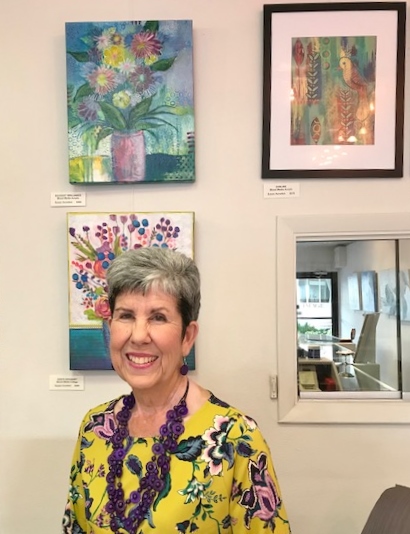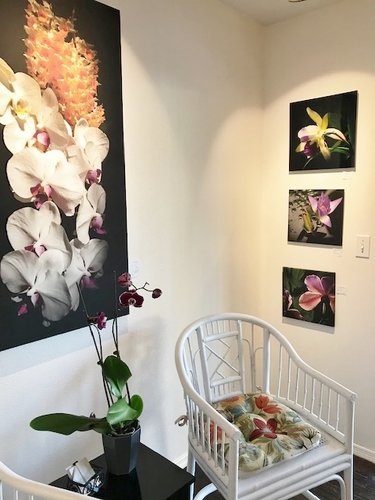by Carolyn Edlund
These self-directed artists didn’t seek gallery representation. Instead, they opened their own retail spaces to display art and interact with collectors.

Artist Susan Hurwitch hangs work for sale in a retail space with four other artists.
The art gallery model is in decline, yet more artists than ever want to sell their work. With a market in transition, this imbalance makes competition fiercer than ever. But there are opportunities for creative entrepreneurs who want to take charge of their own sales and collector relationships. I recently spoke with several Florida-based artists who took this step to sell their work without the need for gallery representation.
Artist Collaboration
Painter Susan Hurwich collaborated with four other artists to negotiate space in The Golden Image, a retail jewelry store in downtown Sarasota, Florida. Their arrangement with owner Peter Woodruff allows for a revolving display of artwork to grace the walls of his store, offering a varied selection to shoppers. Hurwitch was very pleased with her decision to collaborate.
“It was happenstance that the artists selected worked in different mediums, and that each possessed complimentary business-related abilities. These unique qualities, coupled with a strong spirit of collaboration, have been key to our success in a shared environment,” said Hurwitch.
A First Friday Art Walk that takes place monthly in Sarasota has also been critical to that success, drawing patrons to artist-hosted receptions. These events create an atmosphere of excitement and accessibility to those who might be intimidated by a more traditional gallery setting. The artists who share the space have also focused on developing ideas for bringing their art to the community using multiple marketing methods. “As group of five, we have been very intentional about making time to discuss ways to find serious art buyers,” Hurwitch said.

Dansa Studio/Gallery offers artworks from Pamela Erickson and Robert Connery.
Gaining Confidence
Artists Pamela Erickson and Robert Connery also wanted to sell their work, but needed a plan to get started. In 2018, they traveled to an art-business conference where they defined their business objective and put together a strategy. Rather than search for a traditional gallery relationship, they rented space together in an art studio center, displaying and selling their art as Dansa Designs.
“What we learned at the conference really gave us the confidence to move forward with our art business,” said Erickson. “We now have a studio/gallery in the historic artist colony at Towles Court in downtown Sarasota. We opened about two months ago and are doing very well!”
She added, “We felt that opening our own studio/gallery would be more cost effective if we could find an affordable space and interact directly with our customers. Setting up our business in its own space would be by our design, which was very appealing. It could have the look and feel we envisioned.”
Customer Contact
Artists have more control in settings that they run themselves, but they must also handle the responsibilities that go with that control. This arrangement may require the artist to open the studio for regular hours, be in attendance or hire help, manage inventory, merchandise and display work for sale. But it also allows critical contact with visitors, which has many benefits.
“Customers can learn more about what they are seeing and how the art was created (and why) when they deal directly with the artist,” said Erickson. “Our space includes my studio where I actively paint and draw. That lends an authenticity to the space where customers can observe the creative process. Then, they have a story to reflect on too. When they own one of our works, they also own a part of the story.”
Customer conversations have led Erickson to consider new lines and pursue licensing opportunities in home decor that she otherwise would not have considered. Being aware of what customers are interested in also helps her determine inventory and cost effectiveness.
These self-directed artists took proactive steps to reach their audience directly without the need to acquire gallery representation. That decision puts them squarely in the role of business owners responsible for marketing and sales. As more artists follow this path of self-direction, they will find that familiarity with effective business strategy is essential to success.
Want to stay current on cutting edge business articles from Artsy Shark, plus artist features, and an invitation to the next Call for Artists? Subscribe to our twice-monthly Updates, and get a free e-book on Where to Sell Art Online right now!




Speak Your Mind